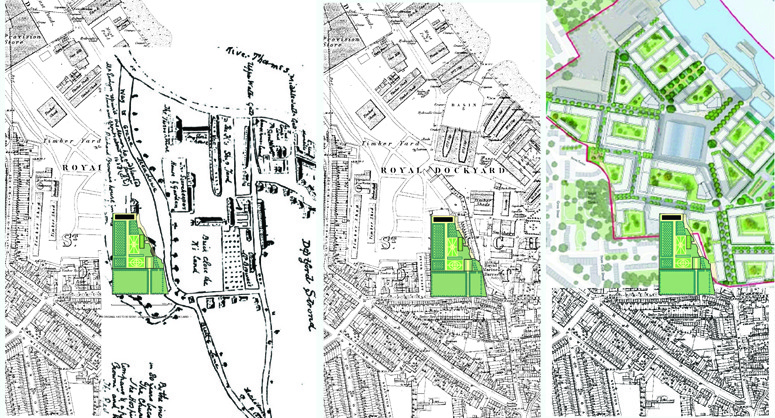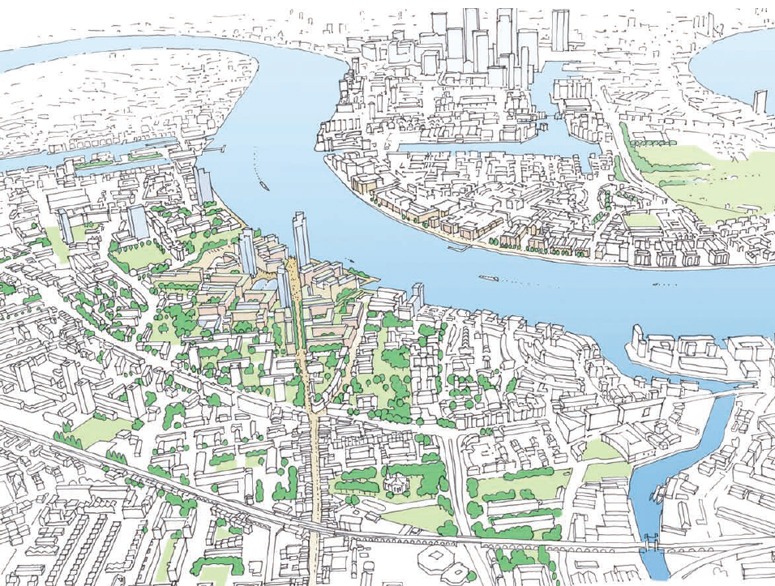
John Evelyn's garden superimposed on plans of the Convoys Wharf site in the seventeenth century, the nineteenth century and, one hopes not, the twentyfirst century
Steen Eiler Rasmussen concluded the second edition of his brilliant book
London: the Unique City with these prophetic words: ‘Thus the foolish mistakes of other countries are imported everywhere, and at the end of a few years all cities will be equally ugly and equally devoid of individuality. This is the bitter END’. So what would he think of the Hutchison Whampoa Master Plan for Convoys Wharf? He would detest it, utterly. The architects are
Aedas, who claim that ‘ We provide international expertise with innate knowledge and understanding of local cultures’. Evidently, this expertise does not extend to the local culture of Deptford – unless they think it is
the same as the culture of London/England/Europe or the World. The planning consultants, let it be recorded, is by
bptw . Their website promises ‘responsible architecture executed with imagination’. Maybe the firm can do this. Maybe the client’s brief made it impossible at Convoys Wharf. Or maybe what the project required was a firm of Urban Landscape Designers, rather than a firm which sees its main business as architecture. The architecture makes one yearn for the imaginative approach one sees in Dubai. The spatial pattern resembles that of the
Ferrier Estate in Kidbrooke, the planting design is what Chris Baines calls ‘a green desert with lollipops’. I am not an admirer of the scheme – and I much regret that John Evelyn’s design for Sayes Court has been cast into what Leon Trotsky called ‘the dustbin of history’. It is a quotation which gives us a lead into the origins of the Convoys Wharf design. In days gone by it might have graced a Parisian banlieue (like Sarcelles), a suburb of East Berlin – or even Moscow itself. With specific regard to the Sayes Court Garden, we should remember that (1) Evelyn, beyond doubt, was the greatest English garden theorist of the seventeenth century (2) Evelyn played a key role in introducing Baroque ideas on garden design to London (3) the Convoys Wharf site would never have come into public ownership were it not for the generosity of John Evelyn (4) Sayes Court was
very nearly the first property to be saved by the National Trust.
THEREFORE the Convoys Wharf site demands a context-sensitive urban landscape design.
Wikipamia shows the present condition of the Convoys Wharf site and the Sayes Court Estate. Also see the
Convoys Wharf Planning Application Documents.

This drawing purports to show 'Landscape, Townscape and Visual Amenity' . Phooey



The important maps of the Environmental Statement Archaeology Technical Appendix are not north faced and not over layered with the situation today. Already on this point there lost the option of a larger context in the history of this place. With a view to Evelyn and his Sylva, or Discourse on Forest Trees and more them with his motto „Omnia explorate; meliora retinete“, the place could be better development. But in this time the ignorance of investors is like the same as Charles II in 1666. Just with this short term investment view about 10 to 15 years is develop a place for the next two or three generations.
There is a lot of information in the supporting documents but one has the impression that the design team has been ‘going through the motions’ instead of doing a serious job, as Evelyn would doubtless have wished, of exploring everything and keeping the best.
A great pleasure to read your post, Tom. I’ve been blogging for a while about Sayes Court over at http://londonslostgarden.wordpress.com and now there is actually a campaign afoot to rescue it from the “dustbin of history” and restore it.
Thank you. I would like to see a National Programme for restoring or re-creating gardens of first class historic importance. John Evelyn’s Sayes Court would certainly be on the list (1) because of his importance (2) because of his role in introducing baroque ideas to England (3) because of scarcity of gardens from the period.
This comment may seem a little off topic, however, I am hoping to illustrate the importance of innovation in architecture resolving what might otherwise seem as incompatibilities in site opportunities.
Even though folded plate architecture [ http://www.eikongraphia.com/wordpress/wp-content/8%20FOA%20Yokohama%20Terminal.jpg ] and landscape architecture [ http://cdn.archdaily.net/wp-content/uploads/2009/07/02-entangled-bank-elevated-park-528×352.jpg ] are fashionable, opportunities to use them as solutions to design problems rather than as stylistic solutions are often missed.
They lend themsevles ideally to an ambiguous above ground/underground architectural vocabulary.
[ http://www.geckogo.com/Attraction/Finland/Southern-Finland/Helsinki/Temppeliaukion-Kirkko-Rock-Church/ ]
The Sayes Court scheme perhaps need further lateral thinking to fully incorporate the historical gems on the site (including Evelyn’s garden)?
I like folded plates and it is always time for innovation, lateral thinking, forward thinking and backward thinking. The problem with the Convoys Wharf scheme is that it scarcely seems to have the benefit of any architectural thinking. It looks like the work of a design conglomerate which has developed a ‘product’, much as Nokia might develop a world phone, and now seeks to roll it out in London. To be fair though, there are two aspects of the scheme which I like (1) the projection of Deptford High Street to the River Thames (2) the creation of roof-garden style ‘London Squares’.
I think they should set about the project by designing the urban landscape first and the architecture second, as West 8 did for the Borneo development in Amsterdam. The architecture can then be much more varied and it can be the work of many more designers. The day of the megastructure was yesterday.
The Borneo development in Amsterdam is very interesting. This analysis of the ‘urban theory'(?) [I would have thought ‘urban practice’] is also instructive, because it details both the aspects which were achieved and those that were modified as the project progressed. [ http://urbantheorywest8amsterdam.blogspot.com/ ]
Comparing the resulting aesthetic of the development to the large social housing (?) project in the background of the 4th photograph the strategy of engaging many designers has achieved a great result for the residents and the Amsterdam cityscape.[ http://www.west8.nl/projects/borneo_sporenburg/ ]
Hi Tom, can we blog about your post on Deptford Is… ? (It’s a blog about the Convoys site and a campaign against it)…Please reply to my email address sue@fivetonine.co.uk, or deptfordis@yahoo.co.uk
Sx